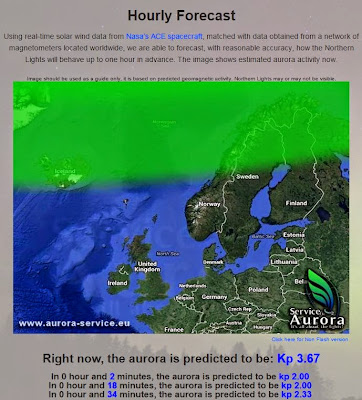 |
| The Aurora Borealis seen at Ersfjordbotn in Tromso, March 2015 |
1) Go with a tour group specifically chasing the Aurora. They will pick you up from the city center and bring you to wherever place they predict to have a clear view of Aurora for that particular day. Sometimes you may be on the road for 2 hours just to get to a place, and sometimes only 30 minutes. Plenty of tour package offerings you can find out from the net, and prices may range depending on group size, season of the year etc.
2) Chase the lights by yourself - which requires you to know more about how and when and where to go, plus with a little bit of luck. This was my choice.
Question 1: Where?
The Aurora Borealis is only visible inside the Arctic Circle (i.e. about 66 deg north of Equator). Based on my little search over the net, apart from Tromso in Northern Norway, other popular places to chase the lights are at Northern Finland, Northern Sweden, Alaska, and also Iceland.
So, once in Tromso, where did I go to find the Aurora?
The best place to see it is at the darkest place possible, i.e. away from light polluted areas such as city center and some small villages. You may choose to either go further inland (i.e. towards Finland border), or you may opt to go to the shore side. Make yourself familiar with the map so that you can make good decision on where to go.
 |
| I used Google Earth apps as a basic guideline to understand the geographical information of places I want to go |
Question 2: When?
Generally speaking, Aurora is said to be visible normally during the time period of November to March. I went there in the middle of March, so I was really praying hard that the solar activity is still active by that time of the year. Outside of this time window, there may still be some aurora activities but the chance of seeing them is much lower.
Ok, another aspect to answer the question "when" is, 'when exactly' is the best time to chase the aurora? I think this is the most important thing to know, because aurora does not happen all the time or at the same time everyday. It's very random, as it depends on solar activity.
Upon talking to the guides at Tromso's tourist information center, they recommended me to check on these few websites as a guidelines.
 |
| www.spaceweather.com gives you some idea (with recent updates) on the general aurora activity at the Arctic Circle |
 |
| www.aurora-service.eu also provide very updated forecast of aurora activity. The higher the Kp number, the higher the chance you'll be seeing the aurora. |
 |
| www.yr.no is where you can find weather forecast for Norway as a whole. Check for clouds and precipitation, and go to places with the clearest sky. Any trace of clouds in the sky and you won't be able to see the aurora. |
 |
| www.windyty.com is another good website you can use to predict the cloud movement, especially in predicting whether or not the sky will be cleared up from the cloud, which depends on the wind movement. |
With these information, you should be able to intelligently plan for your aurora chasing activity. However, because this is a natural phenomena, there's no 100% guarantee you will get to see it.
At some point, you may have a slight feeling like you are becoming a meteorologist hahaha...
Anyway, I have to stop here. I guess I have to continue in another blog entry for the topic of how to photograph the Aurora. Good luck with your chase!
P/s: Read here for Ep.1 and here for Ep. 2

2 comments:
Wish you write more episodes. But hey, it was a solo trip?
Yes it was a solo trip. Thanks for visiting this old blog Zamia :)
Post a Comment